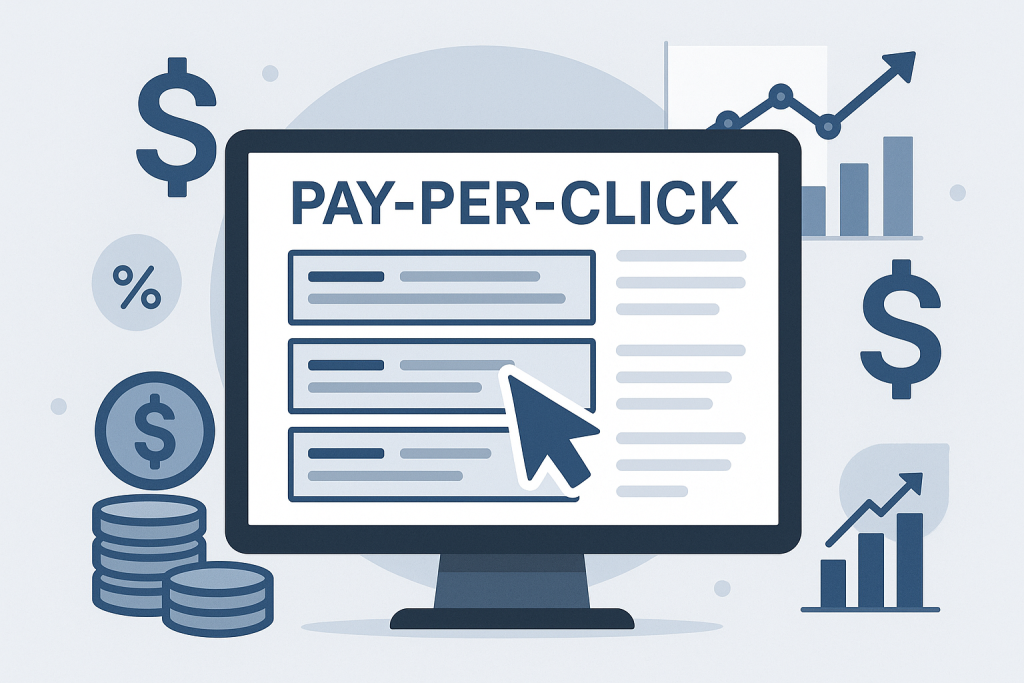
Digital marketing has turned into a must for financial services firms. People don’t look for help in the same ways they used to. They search online first. They read reviews, compare websites, and expect to find clear details before they ever pick up the phone. If your firm doesn’t show up or looks outdated, you lose trust right away. A strong online presence of your finance or banking business helps you get noticed by your target audience, look professional, and prove you know what you’re doing.
Proven Digital Strategies to Market Financial Services
This guide walks through different proven digital marketing methods that you can follow to make your website visible in the online marketplace.
1. Build a Financial Services Website

Your website is usually the first place someone learns about your firm. If it feels cluttered or confusing, they’ll leave fast. If it looks clean and professional, they’ll feel more comfortable reaching out.
Show Clear Financial Services and Expertise
List all your services in plain language. Don’t make people guess what you do. Whether it’s retirement planning, tax help, or investments, lay it out clearly. Add short bios for your team. Share your certifications, years of experience, and areas you focus on. Use real photos. Stock pictures don’t build trust the same way.
Put your phone number and email in a spot that’s easy to find. A simple contact form helps people get in touch without hunting around.
Create a Mobile-Friendly Financial Advisor Website
Most people check financial websites on their phones. If your site loads slow or buttons are too small, they’ll move on. Make sure pages load fast. Keep menus simple. Use big, clear buttons and short forms that work well on a small screen. Add calls to action that stand out, like “Book a Free Consultation” or “Download Your Planning Guide.
Use Compliance Disclaimers on Your Website
Financial firms have to follow strict rules. Add disclaimers where you need them. For example, if you share any performance numbers, say that past results don’t promise the same outcome in the future. Check your local rules so you don’t miss anything. It’s easier to do it right up front than fix problems later.
2. Use SEO to Boost Visibility

When people look for help with money, they usually start with a search. If your firm doesn’t show up, you’re already behind. Good SEO helps you get in front of clients who are ready to take action.
Use Keywords for Financial Services SEO
Start with words people type into Google. Think about what your clients would search for. Terms like:
- Financial advisor near me
- Retirement planning help
- Wealth management firm
- Tax planning services
Use these phrases in your page titles, your headings, and your main text. But don’t overdo it. If you stuff keywords everywhere, it looks sloppy. Make sure everything still reads naturally. Add local keywords too. If you mainly serve your city, mention it in your text. For example: “Financial planning in Denver” or “Estate planning services in Dallas.
Improve Local SEO for Financial Advisors
Local SEO is what gets you on the map when someone searches nearby. Start by claiming your Google Business Profile. It’s free and helps your firm appear in local results. Make sure your name, address, and phone number match exactly what’s on your website. Even small differences can hurt your ranking.
Upload photos of your office and team. This helps people feel like they know you before they call. Ask happy clients to leave a review. Just a few honest reviews can move you higher in search and make you look more trustworthy. List your business on directories like Yelp, Bing Places, and any financial directories you can find. Keep every listing updated.
3. Financial Services Content Marketing Strategies

Good content is one of the easiest ways to build trust. When you share clear answers, people see that you care and know what you’re doing.
Write Blog Posts About Financial Planning
A blog helps you get noticed in search and gives visitors a reason to come back. Start by covering common questions like:
- How do I start saving for retirement?
- What tax changes could affect me?
- Should I pay off debt or invest first?
Keep your writing simple. Break long ideas into short parts. Use headings so people can scan quickly. End each post with a link to your services or a button to book a call. Make the next step obvious.
Offer Free Financial Guides and Resources
People appreciate tools they can use right away. A good guide or checklist shows you’re here to help, not just sell. Ideas for resources:
- A retirement planning checklist
- A monthly budget sheet
- A short guide to building wealth
Ask for an email before someone downloads your guide. This lets you stay in touch without pressure. Make sure everything looks clean and easy to follow. If it feels messy, people might not trust the advice.
Create Financial Education Videos
Some folks prefer watching a video to reading a long page. Short clips can explain topics in a friendly way. You don’t need fancy gear—just a phone, good light, and a steady hand.
You could film:
- Tips for picking retirement accounts
- How to prepare for your first meeting
- Simple ways to save on taxes
Keep videos under five minutes. Speak in plain language. End with a clear next step, like “Call us to learn more.
4. PPC Advertising for Financial Services

Paid ads help you reach people who are already looking for advice. When someone searches for help with money, your ad can show up at the top.
Run Google Ads for Financial Advisors
Google Ads can bring in good leads fast. But you have to keep them honest. Don’t say things you can’t prove, like “We’ll grow your money overnight.” Use clear lines like “Talk to a financial advisor” or “Get help with retirement plans. Choose keywords your clients might type in. Simple phrases work best:
- Financial advisor near me
- Retirement planning help
When someone clicks, send them to a page that matches your ad. If you promise a guide, the guide should be easy to find right away.
Use Retargeting Ads for Financial Services
Most people won’t call you the first time they see your site. Retargeting lets you show ads later so they remember you. If someone visits and leaves, your ad can show up again while they read news or check social media.
Keep these ads plain and friendly. A soft reminder works better than loud promises. Launch Social Media Ads for Financial Firms. Social ads help you share guides, videos, or events with the right people.
LinkedIn is good if you work with professionals. Facebook helps you reach families and local clients. Start small. Try one or two ads. Test a few headlines or photos to see what people click. Over time, you’ll see what gets results.
5. Email Marketing for Financial Advisors
Email is still one of the best ways to stay in touch with clients. It feels personal, and it doesn’t cost much to run.

Send Financial Services Newsletters
A short newsletter keeps your firm fresh in people’s minds. You can share simple updates, like:
- Market trends or tax tips
- New guides you’ve created
- Reminders about important deadlines
Keep each email short. One main idea is enough. Use a clear subject line so people know what to expect before they open it.
Build Email Nurture Campaigns
Not everyone is ready to pick up the phone right away. A few helpful emails can build trust over time. Set up an automatic series. For example:
- First email: Thanks for downloading your guide
- Second email: How to get ready for your first meeting
- Third email: Meet our team and see how we help
- Fourth email: Ready to talk? Book a call
These messages go out slowly, maybe once a week. They keep your firm top of mind without feeling pushy.
6. Social Media Marketing for Financial Services

Social media helps you stay visible and build trust before someone ever calls. You don’t need to be everywhere. Pick the channels that fit your audience.
Use LinkedIn for Financial Advisor Branding
LinkedIn is a solid place to share insights and connect with professionals. Post short updates about market trends or tips on planning. Share articles you’ve written. When someone checks your profile, they should see you’re active and ready to help.
Join groups where your clients spend time. Answer questions if you can. A little effort builds trust.
Build Trust on Facebook for Financial Services
Facebook works well for staying in touch with local clients and families. Share reviews, photos of your team, and posts about community events. Keep it friendly. If someone leaves a comment or asks a question, reply quickly.
Grow a YouTube Channel for Financial Education
Video helps people understand tricky topics. You don’t need fancy equipment. Just record clear videos that explain things in simple language. Ideas include:
- How to start a budget
- What to expect in a retirement plan
- Steps to reduce tax stress
Keep videos short, around 3–5 minutes. End with a soft call to action, like “Visit our site to learn more.
7. Reputation and Brand Management

Trust is everything in finance. People want to feel sure they’re working with someone honest. What others say about you online can help them decide.
Collect and Reply to Financial Services Reviews
Reviews are often the first thing someone reads before calling you. After you finish helping a client, ask if they’d share a short review. Even a few lines can make your firm look more reliable. Look at your reviews regularly. If someone leaves good feedback, thank them. If there’s a complaint, reply calmly and offer to talk in private. Being polite shows you care and pay attention.
Monitor Your Brand Across Digital Platforms
It helps to know when people mention your firm. Set up Google Alerts for your business name. You’ll get an email anytime it pops up online. If you see your name in a post or an article, you can thank them or clear up anything that’s not right. Staying aware keeps your reputation strong.
8. Use Advanced Digital Ad Options

Once you’ve got the basics working, you can try a few extra ways to reach people. These tools help you stay in front of folks who might need your help.
Programmatic and Display Ads
Programmatic ads target people based on what they read or search for. If someone has been looking up retirement tips, your ad could show up on a news site they visit later. Display ads are the banners you see on websites. They’re good for reminding people about your firm.
If you use these ads, work with someone who knows the rules in finance. You don’t want any trouble over compliance.
SMS and Mobile Campaigns
Text messages work well for reminders or short notes. You could send a message about a free guide or an upcoming deadline. Keep texts short. Always ask people to opt in before you start. No one likes surprise texts.
Analytics, Testing, and Optimization
You need to know what’s working and what’s not. If you don’t track results, you’re guessing.
Track Website Leads and Ad Conversions
Use tools like Google Analytics to see how people find you. Look at which pages get the most visits and which ones lead to calls or form fills. Call tracking shows which ads bring in the most calls. Check your numbers every month. That way, you’ll see where to focus.
A/B Test Pages and Campaigns
Try changing one thing at a time. Maybe test a new headline or a different button. For example, “Book a Free Call” might get more clicks than “Request a Consultation. Run your test long enough to be sure. When something works better, use it going forward.
Conclusion
Getting your digital marketing strategy for financial firms and banking institutions right takes time. No magic button brings in clients overnight. But doing nothing means your competitors will get those calls instead of you. If your website is slow or confusing, people will click away fast. If you don’t show up in searches, you won’t even be considered. Don’t feel like you have to launch everything at once. Maybe you start by fixing your site and claiming your Google profile. Later, you can try a few ads or post some simple guides. Just take one step. Then the next. Over time, it adds up.

Tarun Gupta, CEO of Brainpulse Technologies, is a prolific author and digital marketing specialist. His insightful writings span SEO, content marketing, social media strategy, and email campaigns, offering invaluable expertise to businesses worldwide. Tarun’s contributions continue to shape the digital marketing landscape, guiding success in multiple niches.